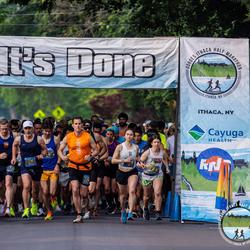I was intrigued by an article in trailrunnermag.com about training easy with heart-rate training. After a thorough read, I think I’ll give it a try after my Fall marathon to help build a strong aerobic base during the winter and spring. The summary of the story was that many runners end up training anaerobically (not intentionally), at a heart rate above their MAHR. According to Phil Maffetone, "95-99% of the energy used for endurance sports, including competition, is derived from the aerobic system." You’ll burn through glycogen in your muscles and liver (2-3 hours’ worth) if you’re training or competing above MAHR, but if you can stay below it, in the aerobic zone, you rely on fat stores (good enough for 100+ hours of activity).
Find Your MAHR Method 1: Phil Maffetone’s 180 Formula
Phil Maffetone suggests a formula of 180 minus your age, with several adjustments based on your training history (see link above for adjustments). For me, the 180 formula asks me to add 5 if I have been training for more than two years without any of the problems listed (again, see the link above for details), and have made progress in competition without injury, add 5.
For me, this is 180-42 = 138 + 5 = 143
[Your MAHR] must be the highest heart rate for all training. This allows you to most efficiently build an aerobic base. Training above this heart rate rapidly incorporates anaerobic function, exemplified by a shift to burning more sugar and less fat for fuel.
Find Your MAHR Method 2: Friel’s 30-minute Workout Method
Elite coach Joe Friel, author of Fast After 50, recommends using a workout to find your MAHR, during which you run at the "maximum, consistent effort you can sustain for 30 minutes. I headed out for a 5-mile run at marathon pace, which was about the pace I could do on this hot and humid morning. Friel suggests using a lap counter after 10 minutes to signify the start of the heart rate data capture. After 20 more minutes of sustained effort, stop that lap counter and calculate the average heart rate.
I uploaded my whole workout to Strava, since it was longer than 45 minutes. I exported the GPX file, deleted some of the data in a text editor to get the 20 minute span I was interested in, and re-uploaded it to have Strava do the heavy lifting of calculating the average heart rate. You could just as easily capture the 20 minutes during your workout, by starting a new workout after 10 minutes, then stopping that workout 20 more minutes in.
I found that my average heart rate for this span was 159 bpm. Multiply that by 0.9, according to running-specific charts in Friel’s book, Total Heart-Rate Training, I’d get an approximation of my MAHR: 143.1 bpm. That’s uncannily close to the 143 I got using the 180 formula!
How does this correlate to my running assessment?
I got a running assessment last year from Cayuga Medical Center, and got a personalized report of my heart rate zones as part of the VO2 max test. The MAHR calculation jibes well with this report, with my Zone 2 (aerobic) between 120 and 139. So, if I stay below 143 I’ll stay in this zone and reap the benefits of aerobic training. We'll see how it goes!
Zone 1, Recovery: HR <125 HR<50% VO2max, RPE <12: Easy training zone with purpose of absorbing heavier training days and minimize risk of overtraining
Zone 2, Base Training Zone: HR 120-139 HR 50-60% VO2max, RPE 12-13: Aerobic zone of moderate intensity. Most of off season training should be spent in this zone with the goal of building a training base.
Zone 3 Ventilatory Threshold: HR 140-155 HR ~60% VO2max, RPE 14-15. Training in this zone will increase your tolerance to lactate and raise your anaerobic threshold. Individuals can remain in this zone for less than 1 hour. This zone is usually typical race pace.
Zone 4, Interval Training Zone: HR 156-186 HR 75%-100% VO2max, RPE 16-19. Can sustain training within zone for 90 seconds to 5 minutes. This zone is beyond lactate threshold and increases VO2max and enhances anaerobic metabolism.
Zone 5, High Intensity Training Zone: HR 187 HR 100% VO2max or higher, RPE 19 or 20. This zone is at or above VO2max and can only be sustained for short bouts of approximately 30-90 seconds.



